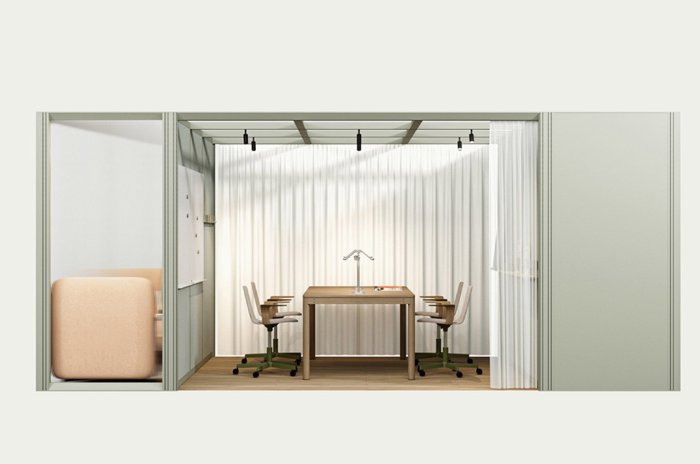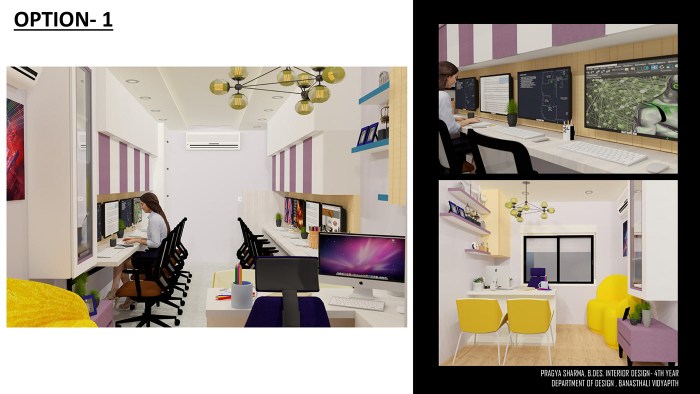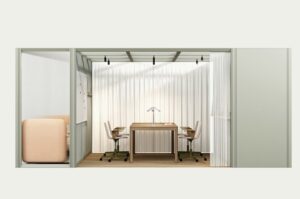
Modular office layouts are revolutionizing the way we think about workspaces, offering flexibility and adaptability like never before. As businesses evolve, the need for environments that foster collaboration and innovation becomes increasingly paramount.
This approach not only allows for the customization of office spaces to meet diverse needs, but also promotes efficiency and productivity by utilizing space in a more effective manner. With the shift from traditional office designs to modular systems, companies can now create dynamic environments that reflect their brand identity while accommodating various working styles.
Modular Office Layouts Overview
Modern workplaces are increasingly adopting modular office layouts, which are designed to be flexible and adaptive to changing business needs. This innovative approach allows companies to create spaces that can be easily reconfigured, promoting collaboration and efficiency. With the rise of remote work and the need for dynamic environments, modular designs are becoming essential in optimizing workspace utility.The significance of modular office layouts lies in their ability to cater to diverse business requirements.
They provide a functional and aesthetically pleasing environment that can support various workflows and team structures. As businesses transition from traditional, rigid office designs to more fluid modular systems, they are discovering numerous benefits that enhance both employee satisfaction and operational efficiency.
Benefits of Modular Office Layouts
Implementing modular office layouts offers several advantages for businesses, including:
- Flexibility: Modular designs allow spaces to be reconfigured quickly and efficiently, accommodating changing team sizes or project needs.
- Cost-Effectiveness: These layouts can lead to reduced construction and renovation costs, as they utilize prefabricated components that are easier to install and modify.
- Enhanced Collaboration: Open and adaptable spaces foster communication among employees, leading to improved teamwork and innovation.
- Improved Space Utilization: Businesses can optimize their available space, creating functional areas tailored to specific tasks or group activities.
Evolution of Office Layouts
The shift from traditional office layouts to modular designs reflects broader changes in workplace culture. Traditionally, office spaces were characterized by individual cubicles and closed offices, which often hindered collaboration. Over the years, the trend has moved towards open-plan environments, and now modular designs are leading the way in creating versatile workspaces that enhance productivity and employee morale.
“Workspaces are a reflection of company culture; modular designs symbolize adaptability and innovation.”
Architecture and Interior Design Impact
The impact of modular office layouts on architectural practices is profound. Architects are now focusing on creating designs that not only meet functional requirements but also enhance the overall employee experience. This shift aligns with a growing emphasis on sustainability and the intelligent use of space.
Influence on Architectural Practices
Modular office layouts challenge architects to rethink how spaces are constructed and utilized. By incorporating prefabricated elements, architects can streamline the design and building process, resulting in faster project completion times and reduced waste.
Successful Modular Office Designs
Several renowned architectural firms have set benchmarks in modular office design. For instance, companies like Gensler and HOK have successfully integrated modular elements into their designs, offering innovative solutions that prioritize flexibility and employee well-being. Their projects often feature movable walls, modular furniture, and multi-purpose areas that adapt to various business activities.
Role of Interior Design
Interior design plays a crucial role in maximizing the functionality of modular office layouts. Thoughtful selection of colors, materials, and furnishings can enhance the aesthetic appeal of the workspace while supporting productivity. Furniture choices, such as adjustable desks and ergonomic seating, contribute significantly to employee comfort and health.
Business Efficiency and Productivity
Modular office layouts significantly contribute to increased efficiency and productivity within organizations. By allowing for quick adaptability to various tasks, these spaces enable teams to work more effectively.
Contributions to Efficiency
The design of modular layouts fosters a workflow that minimizes distractions and enhances focus. By strategically placing workstations and collaboration areas, businesses can optimize the movement of employees and resources.
Case Studies of Productivity Improvements
Numerous companies have reported productivity increases after transitioning to modular office designs. For example, a tech startup noted a 30% increase in collaboration and project turnaround time after implementing a modular layout that encouraged open communication among team members.
Comparison with Traditional Setups
When comparing modular layouts to traditional office setups, the differences in space utilization and workflow efficiency become apparent. Modular designs often allow for more flexible configurations, leading to better use of space and improved employee interactions.
Human Resources Perspective
From a human resources viewpoint, modular office layouts have significant implications for employee collaboration and morale. These designs create environments that can adapt to various work styles, making them ideal for diverse teams.
Collaboration and Morale
Flexible office designs encourage spontaneous interactions among employees, which can boost morale and foster a sense of community. When employees feel comfortable and connected, they’re more likely to contribute positively to the workplace culture.
Accommodating Diverse Work Styles
Different employees have unique work preferences and styles. Modular layouts allow HR teams to create spaces that cater to various activities, from quiet zones for focused work to communal areas for brainstorming sessions.
Strategies for Implementation
To successfully implement modular layouts, HR departments should actively seek employee feedback during the design process. Engaging staff in discussions about their needs and preferences ensures that the final design promotes satisfaction and productivity.
Furnishings and Supplies
Choosing the right furniture and supplies is crucial for maximizing the effectiveness of modular office layouts. The selection process should prioritize both functionality and employee comfort.
Selecting Appropriate Furniture
When selecting furniture for modular spaces, companies should consider options that are versatile and easily configurable. Modular desks, movable partitions, and collaborative seating arrangements can significantly enhance the workspace.
Essential Supplies and Furnishings
A well-equipped modular office should include:
- Ergonomic chairs that promote good posture.
- Adjustable desks that cater to standing or sitting preferences.
- Storage solutions that maximize space efficiency.
- Acoustic panels to minimize noise distractions.
Impact of Ergonomic Furniture

Investing in ergonomic furniture is key to ensuring employee health and productivity in modular environments. Properly designed workstations can reduce the risk of injuries and enhance overall job satisfaction.
Change Management in Office Transitions
Transitioning to modular office layouts requires careful planning and management to minimize disruption. Organizations must approach this change thoughtfully to ensure a smooth transition.
Effective Transition Management
To effectively manage transitions, companies should establish a clear plan that includes timelines and objectives. Involving employees from the outset can help to create a sense of ownership and reduce resistance.
Minimizing Disruption
Best practices for minimizing disruption during the transition phase include conducting thorough assessments of current workflows and providing employees with resources and support throughout the process.
Training Employees
Training sessions can help employees adapt to new workspace designs. Providing guidance on how to utilize modular spaces effectively encourages adaptability and ensures that employees feel confident in their new environment.
Business Advertising and Branding
Modular office layouts can serve as a powerful representation of a company’s brand identity. Thoughtfully designed spaces not only enhance employee experience but also communicate brand values to clients and visitors.
Reflecting Brand Identity
A well-designed modular office can reflect a company’s ethos and culture. For instance, a tech company may use bright colors and open spaces to convey innovation and creativity, while a financial firm may opt for sleek, modern furnishings to emphasize professionalism.
Examples of Successful Branding Integration
Several businesses have successfully integrated branding into their office designs. Companies like Airbnb and Google use modular layouts that embody their brand images while promoting a collaborative work environment.
Workspace Aesthetics and Client Attraction
The aesthetic appeal of a workspace can have a significant impact on attracting clients and talent. A visually engaging office can enhance first impressions and contribute to positive client relationships.
Entrepreneurialism and Startups
For startups, modular office layouts offer unique advantages in terms of flexibility and cost-effectiveness. These designs can facilitate rapid growth and adaptation to changing market conditions.
Benefits for Startups
Startups often operate under tight budgets and evolving team dynamics. Modular office layouts allow for scalable solutions, enabling them to expand or downsize without extensive renovations.
Success Stories of Startups
Numerous startups have thrived in modular workspaces. For instance, a coworking space provider that adopted modular designs reported a 50% increase in membership due to their appealing and adaptable environments.
Guide for Entrepreneurs

Entrepreneurs should consider the following when designing a modular office:
- Incorporate flexible furniture that can accommodate various activities.
- Create zones for collaboration and focused work.
- Ensure that the layout aligns with the company’s growth trajectory.
Customer Service Considerations
The layout of a modular office can significantly impact customer service operations. Thoughtful design can enhance customer interactions and improve satisfaction.
Impact on Customer Service Operations
Modular office designs allow for the creation of dedicated areas for customer service teams, ensuring that they can operate efficiently and effectively. A well-structured layout can facilitate smoother processes and quicker response times.
Designing Customer-Facing Areas
When designing customer-facing areas within a modular framework, it is essential to create welcoming and functional spaces that enhance the customer experience. Consideration should be given to seating arrangements, accessibility, and technology integration.
Influence on Customer Interactions
The layout and design of a modular office can significantly influence how customers perceive a brand. A well-organized, aesthetically pleasing environment can lead to positive interactions and increased customer loyalty.
Construction Industry Trends
The construction industry is witnessing a growing trend toward modular construction in the office sector. This shift is driven by the need for efficient, sustainable building practices.
Growing Trend of Modular Construction
Modular construction reduces both time and costs associated with traditional building methods. By utilizing prefabricated components, construction timelines can be significantly shortened, allowing businesses to occupy spaces sooner.
Environmental Benefits
Modular office layouts contribute to sustainable construction practices by minimizing waste and promoting energy efficiency. These designs often utilize materials that are recyclable and environmentally friendly.
Challenges and Solutions in Implementation
While there are challenges to implementing modular design in construction projects, such as regulatory hurdles and supply chain issues, innovative solutions are emerging. Collaboration between architects, builders, and clients can lead to successful modular projects that meet both aesthetic and functional goals.
Wrap-Up
In conclusion, embracing modular office layouts can significantly enhance business operations, employee satisfaction, and overall company culture. By leveraging the benefits of flexibility, strategic design, and enhanced collaboration, organizations are better equipped to thrive in today’s fast-paced business landscape.
Common Queries
What are the key benefits of modular office layouts?
Modular office layouts offer flexibility, space optimization, enhanced collaboration, and can adapt to changing business needs.
How do modular office layouts differ from traditional designs?
Unlike traditional designs, modular layouts are adaptable and can be easily reconfigured to suit different functions or team sizes.
Can modular layouts improve employee morale?
Yes, they create collaborative spaces that promote interaction and creativity, positively impacting employee morale.
What factors should be considered when choosing furniture for modular spaces?
Consider ergonomic design, flexibility, and how furniture can support the intended layout and functionality of the space.
Are modular office layouts cost-effective for startups?
Absolutely, they allow startups to save on costs while providing the flexibility needed for growth and change.




